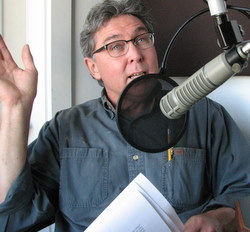The affordable housing problem in Sitka affects everyone in some way, but it’s most acute for people who are actually trying to buy a house.
Twenty-five years ago, it could be done on one income. Nowadays, buying a home is out of reach for a lot of two-income families.
Randy Hughey would like to change that. The recently-retired high school shop teacher wants his grown children to have the same opportunity to build a life in Sitka that he did.
In the fourth and final part of our interview series on Community Land Trusts, KCAW’s Robert Woolsey spoke with Hughey about his passion for changing the paradigm of Sitka’s housing market.
Listen to iFriendly audio.

SCDC board member Randy Hughey wants to change the economics of home ownership for young families. (KCAW photo/Robert Woolsey)
Around the end of the school year, the high school wood shop is stacked with projects of all kinds — 40 night stands made by the Wood I students here, spectacular gun cases and entertainment centers made by more advanced kids there.
Randy Hughey has an amazing capacity for getting projects across the goal line.
“Everyone agrees affordable housing’s a problem. Let’s do something.”
Hughey thinks houses have just grown too large. Too much square-footage per occupant.
When he was growing up, his family of six lived in an 800-square foot house. By the time he was in high school, they had moved to an 1,100-square foot house.
“It was affordable. My parents weren’t financially stressed. We lived on one blue-collar income, and we didn’t know that it was a problem. In hindsight you look back and say, How did we ever do that? — we were pretty packed in there! But it was entirely doable.”
The national average house now is 2,300 square feet.
Hughey is on the board of the Sitka Community Development Corporation, which is exploring the idea of establishing a Community Land Trust as a way to create affordable housing.
Take a brief survey about Community Land Trusts from the Sitka Community Development Corporation.
CLT’s reduce the cost of a home by about one-third, by selling only the structure to a buyer, and holding the land in trust.
According to data compiled by the Sitka Community Development Corporation, a typical house in town costs around $350,000. To buy it conventionally, someone would have to come up with a cash downpayment of 20-percent, or $70,000. Even at today’s low mortgage interest rates, it would mean payments of over $3,000 per month with a 15-year term, including utilities, taxes, and insurance.
View the SCDC’s Affordability Calculator online.
Some families have the cash to pull this off, and…
“Well, there are lots of families that do not. And no just-around-the-corner opportunities for that to change significantly.”
Hughey believes a Community Land Trust is another form of opportunity. Building smaller homes in the trust is a further way to pare down costs, and broaden opportunity.
The small houses he was raised in were not demeaning; modern designs are flourishing online and make smaller houses downright attractive.
Hughey thinks all the pieces are here to solve the affordability puzzle.
“I want to change the economics of a family here. I want to make it so that not everybody has to work all of the time, and that there’s always pressure on mom and dad financially to have a house to live in. I want to get out of rentals, and I want to get out of much of the substandard housing that’s being lived in here. And I do not want giveaway programs. I want there to be something where people have to invest, to bring something to the table. They then have ownership — they are vested in it — and they have a benefit in doing maintenance and upkeep of the home. And they can get the nest egg that they need to get out on the open market.”
The Sitka Community Development Corporation has spent the past two months running articles in the local paper — and appearing on radio — to make the case for Community Land Trusts. Because CLTs involve ownership, allow buyers to build equity, yet limit profit on resale, they’re seen as a kind of hybrid between the open market and more tightly-controlled housing projects.
Still, you have to start somewhere with a Community Land Trust. It can often involve the donation of municipal property. The SCDC thinks education ahead of time will build the necessary political will.
“We’re talking about the allocation of publicly-owned resources toward a particular problem. We’re going to need people’s support for that. Not just on the assembly. I think there needs to be a broad agreement that this is an affordable housing model that should be tried. Then, we just try.”
Hughey is adamant that a CLT is not a charity. He doesn’t see Habitat for Humanity, or a high school vocational program, putting up one or two houses a year. He thinks the situation is far too acute. A CLT, he believes, is going to put carpenters to work. Political boundaries can be changed to make land available; the existing development and construction industry can be called in to help accurately forecast costs.
Hughey says it’s time for all hands on deck.
“It’s a problem that is worthy of our best efforts, because it’s our children. I want to create a community where my children could come back and live in. Or your children — or all of the people my age in town who have kids: I want them to be able to come to Sitka and raise their families here. Bring my grandchildren home. That’s why I’m working on it.”






























